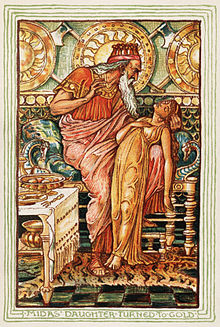Midas
Midas ( Greek Μίδας) is the name of several kings of Phrygia . Some of them have a mythical character; However, at least one Midas is documented as a historical person in contemporary sources.
myth
The legendary Midas is said to have been a son of Gordios and Cybele and to have dedicated the great sanctuary in Pessinus to his mother .
As a child, while he slept, ants are said to have carried grains of wheat into his mouth. From this he was prophesied that he would become very rich.
There were several ancient mythical anecdotes about his greed and stupidity, such as the following:
To become as wise as Silenus , Midas believed that it was enough to catch him. He set a trap for him by adding wine to a forest spring, from which Silenus drank and fell asleep intoxicated. Dionysus , who missed his old teacher, had to grant the king a wish for his release. Midas wished that everything he touched turned to gold. The wish was granted to him. But now that food and drink became gold for him, he was threatened with death from hunger or thirst. So he asked God to take back the gift. Dionysus advised him to bathe in the river Paktolos , to which the gift then passed, so that it became the gold richest river in Asia Minor .
At the Pactolus River (now Sart Çayı, Western Turkey), the ancient city was Sardis (Greek Sardis , Turkish Sart ), in which the fabulously wealthy last Lydian King Croesus resided.
According to another narrative, Midas awarded the prize to Pan in a musical contest between the ugly Pan and the well-formed Apollon , the representatives of the Syrinx and the Kithara , for which Apollo pulled his ears to two donkey ears (cf. Bach cantata The dispute between Phoebus and Pan ). Midas hid this disgrace under a Phrygian cap . Only his barber saw them. Although not daring to reveal the secret of a man, but could the urge to pass it on, do not resist, dug a hole on the river bank and whispers into it , what he has seen for ears. Then he tossed it again. But the reeds had overheard and whispered it on to other rushes when the wind rustled, so that in the end everyone knew. Accordingly, antiquity already knew an expression for general acquaintance comparable to the German truism .
history
The historical Midas was in the 2nd half of the 8th century BC. BC ruler of the Phrygian Empire, which then ruled large parts of Anatolia . It is attested in both Greek ("Midas of Phrygia") and Assyrian ("Mita of Muški ") written sources. When the Cimmerians invaded the Phrygian Empire and the capital Gordion was on the brink of collapse , Midas took his own life - according to a Greek story by drinking bull's blood. Whether it was the same Midas who, according to Eusebius (31, 72 ff.) From 738 B.C. Ruled and 696 BC. Died is unclear. That depends, among other things, on the date of Gordion's destruction - 696 or 679 BC. Chr. - from. In the past, the former was preferred and assumed to be the same person. Since more and more ancient historians and archaeologists to 679 BC Some of the research now assumes that the Midas of the 8th century and the Midas, under whose rule Gordion fell, are two different kings with the same name.
A large tumulus near Gordion, which contained many precious grave goods, has long been considered a possible grave of Midas. Due to stylistic criteria, some objects were brought to the time around 700 BC. Dated. A piece of wood was dendrochronologically recorded as the felling date 718 BC. Determined. The skeleton of a 60–70 year old man was found in the grave. It all went well with the famous historical King Midas. In the meantime, however, more recent scientific data have been determined according to which the grave is older. Stylistically, some of the additions are also considered to be significantly older, as the corresponding layers in the Gordion settlement were also dated much earlier. This means that it can now be ruled out that the historical Midas, which according to Greek sources was in the early 7th century BC Died, is buried. A reconstruction of the burial chamber can be seen in the Museum of Anatolian Civilizations in Ankara .
According to William Francis Ainsworth , a 19th century explorer, the name Midas could also be read on a grave near Seyitgazi (near Eskişehir ).
See also
- Midas City (Midas Şehir)
- The judgment of Midas , comedy by Christoph Martin Wieland
- King Midas , comic opera in one act by Wilhelm Kempff
- Midas complex
literature
- Wilhelm Drexler : Midas . In: Wilhelm Heinrich Roscher (Hrsg.): Detailed lexicon of Greek and Roman mythology . Volume 2.2, Leipzig 1897, Col. 2954-2968 ( digitized version ).
- Johannes Scherf: Midas. In: The New Pauly (DNP). Volume 8, Metzler, Stuttgart 2000, ISBN 3-476-01478-9 , column 154 f.
- Anneke Thiel: Midas. Myth and Transformation. Winter, Heidelberg 2000, ISBN 3-8253-1043-4 (also dissertation, University of Münster 1998).
- Anneke Thiel: Midas. In: Maria Moog-Grünewald (Ed.): Mythenrezeption. The ancient mythology in literature, music and art from the beginnings to the present (= Der Neue Pauly . Supplements. Volume 5). Metzler, Stuttgart / Weimar 2008, ISBN 978-3-476-02032-1 , pp. 429-432.
Web links
Individual evidence
- ↑ Arrian , Anabasis 2,3,1
- ^ Hyginus , Fabulae 274
- ^ Heinrich Wilhelm Stoll: The gods and heroes of classical antiquity , Verlag BG Teubner, Leipzig 1861, p. 289
- ↑ Marcus Tullius Cicero , De divinatione 1,36
- ↑ Xenophon , Anabasis 1,2,13
- ↑ Ovid , Metamorphoses 11, 85-145; Hyginus, Fabulae 191
- ↑ Ovid, Metamorphoses 11, 146-193
- ^ Max Duncker: Volume 1 of Geschichte des Alterthums , Verlag Duncker and Humblot, 1863, p. 745.
- ^ William Francis Ainsworth: Travels and Researches in Asia Minor, Mesopotamia, Chaldea and Armenia Volume 2. London 1892, p. 59.


